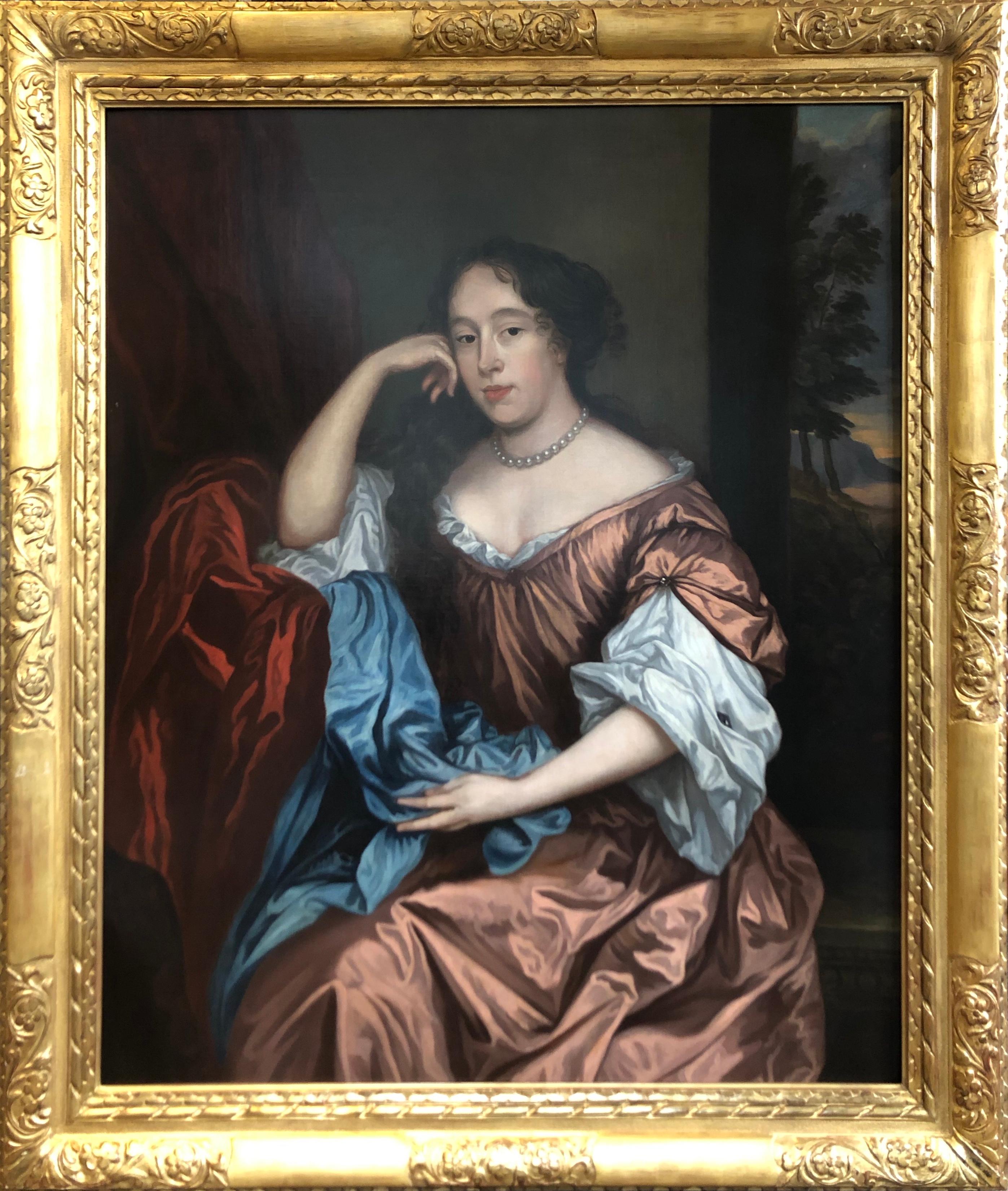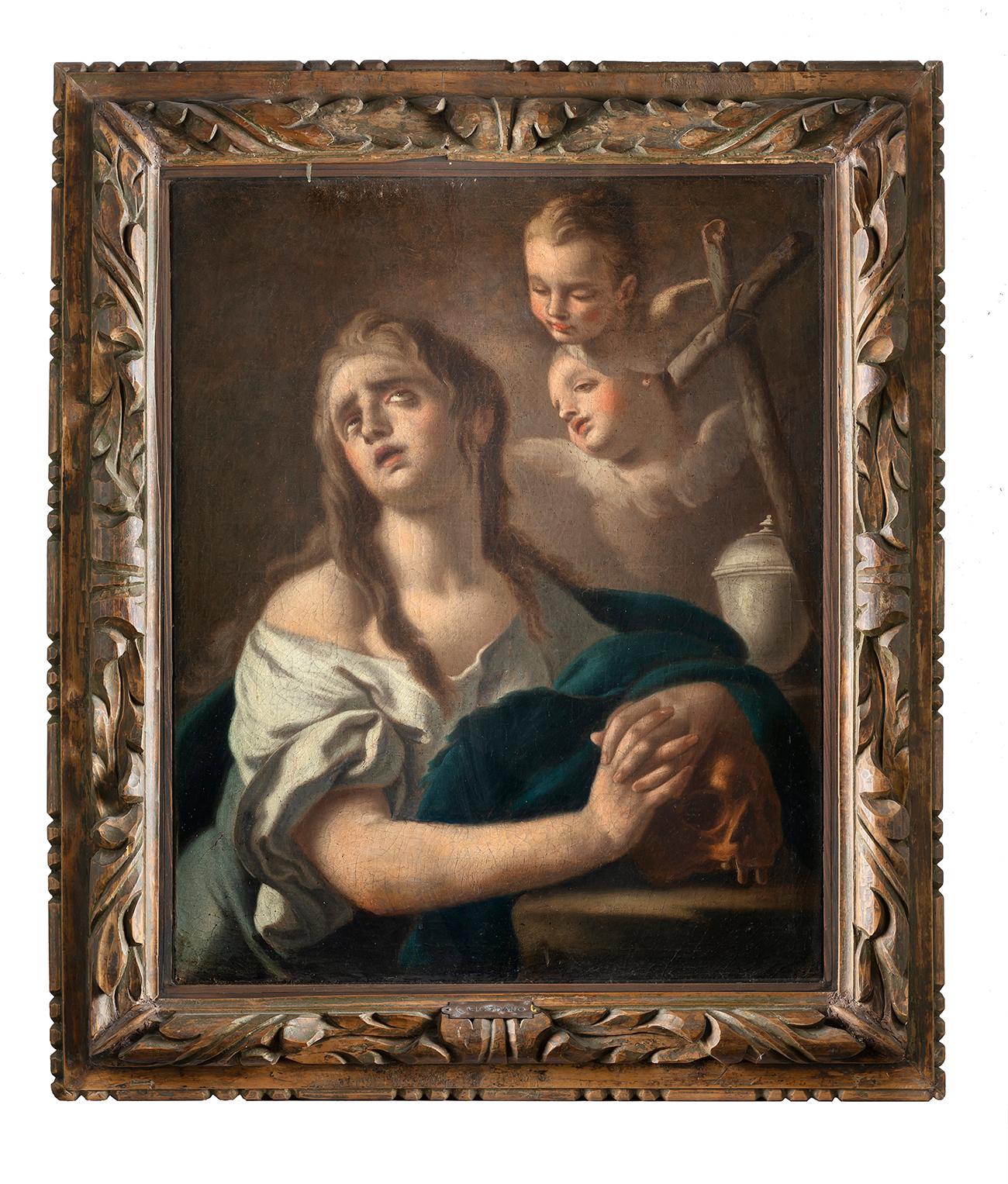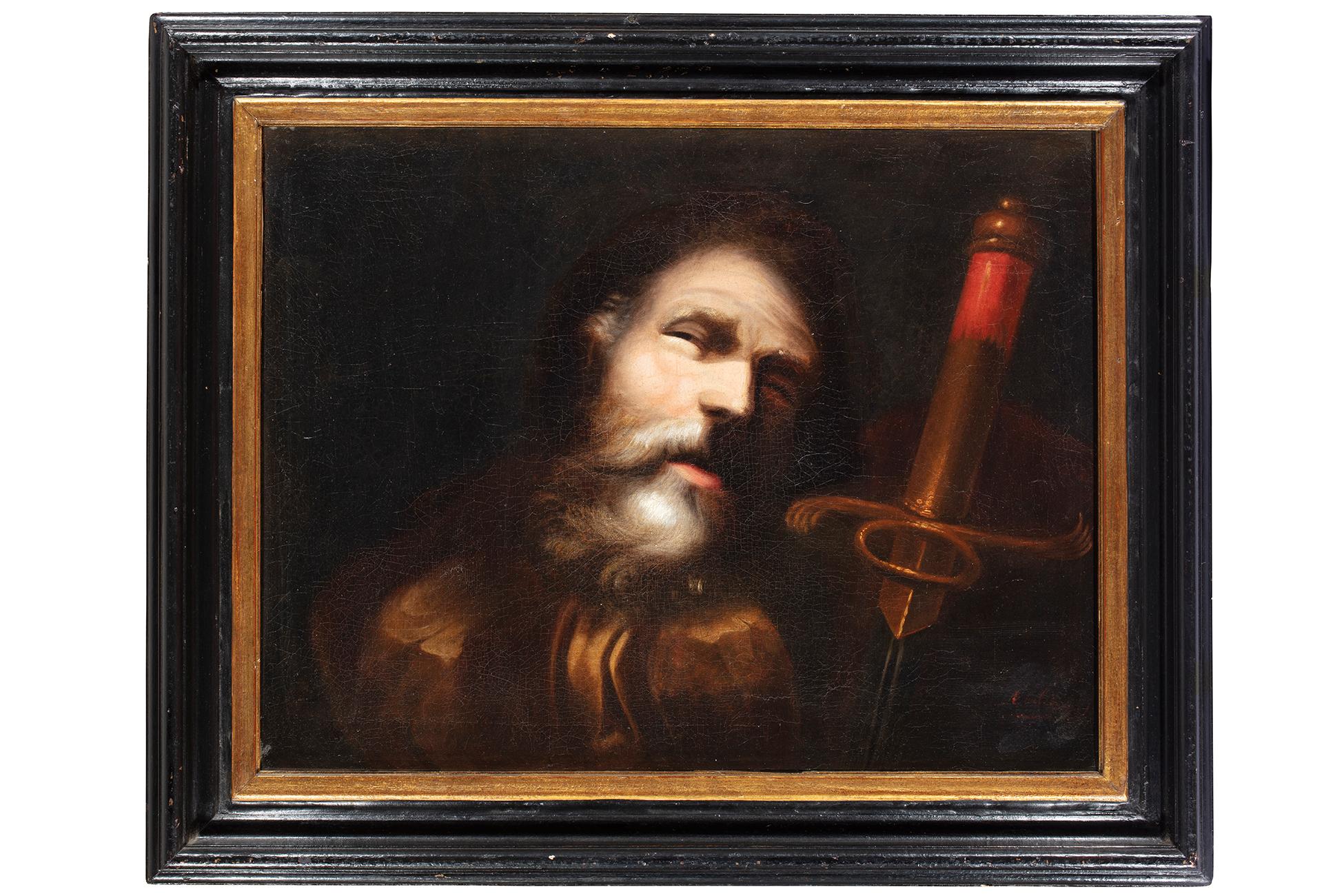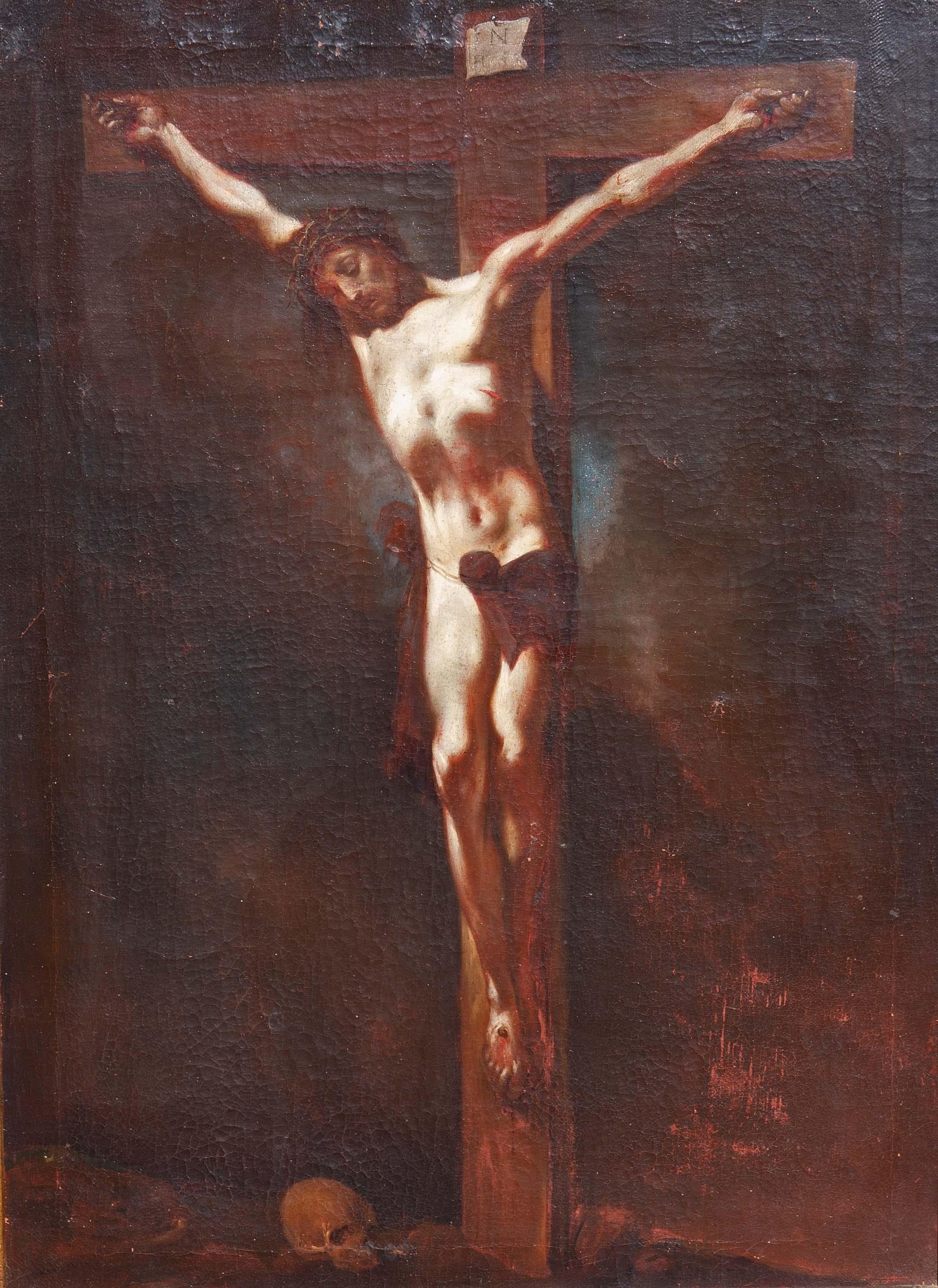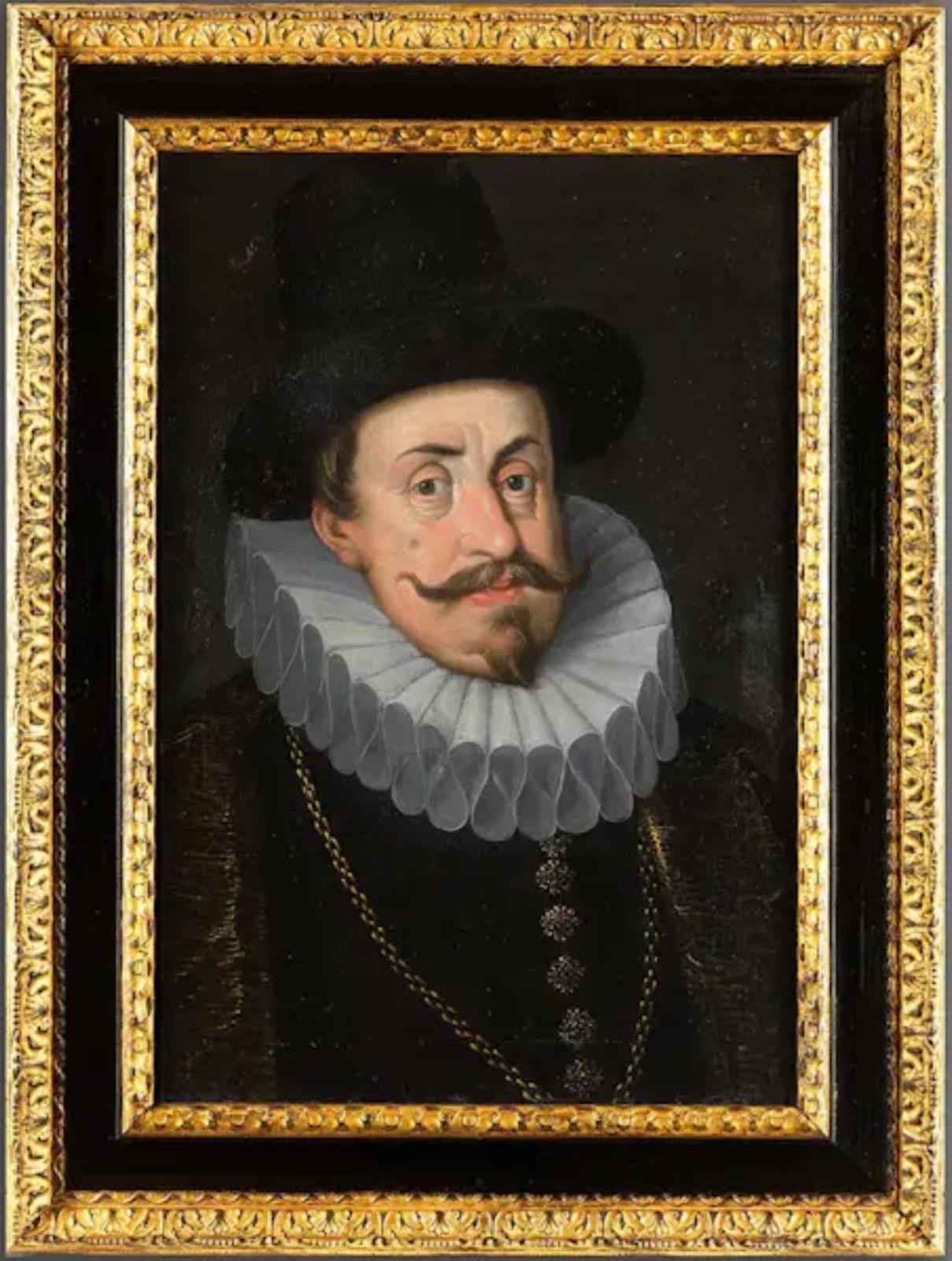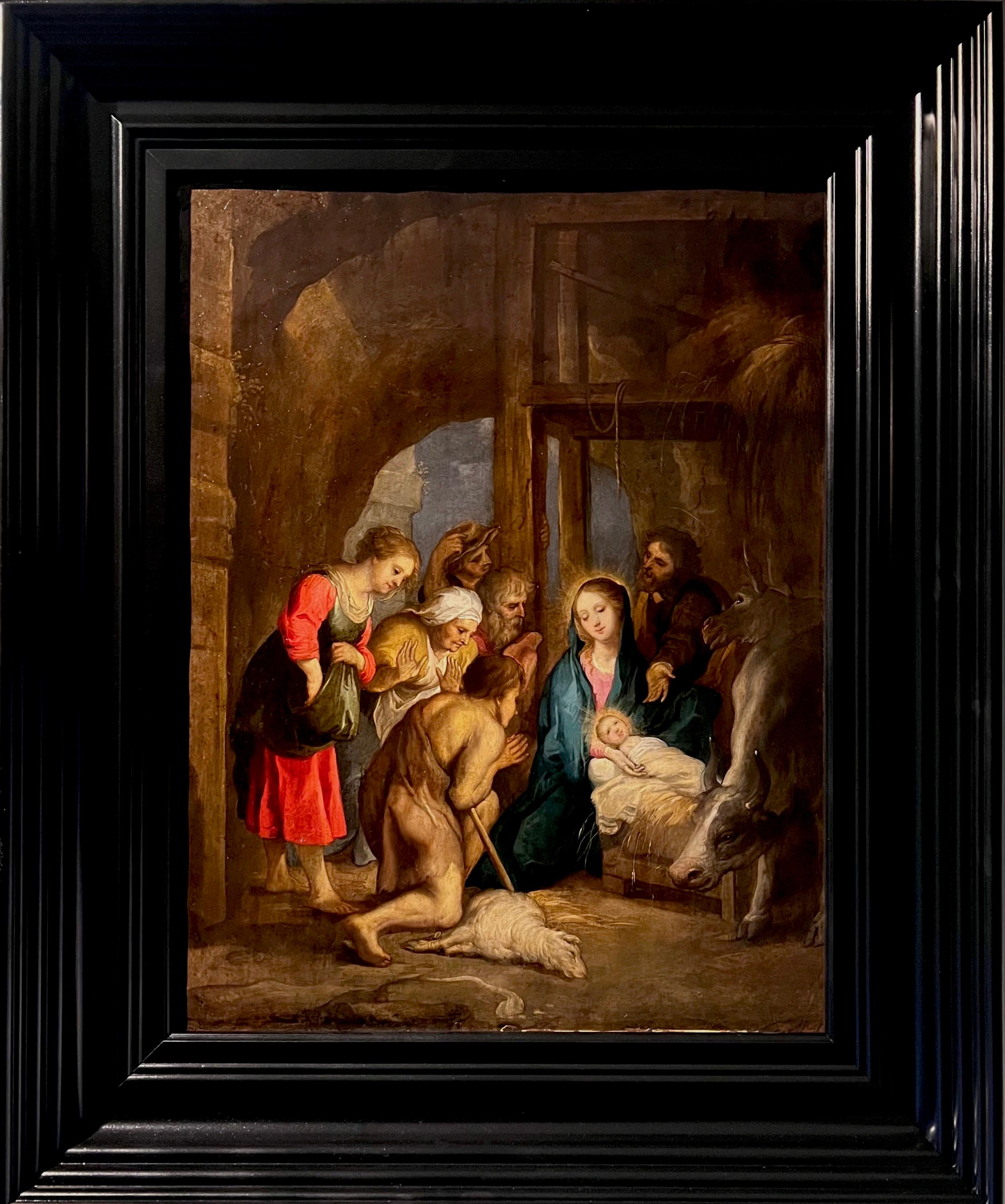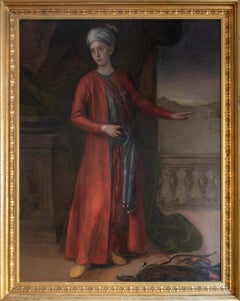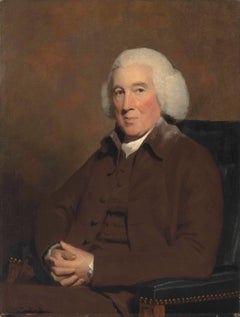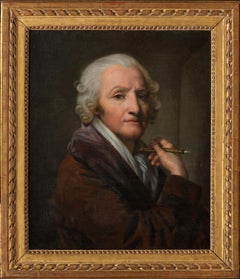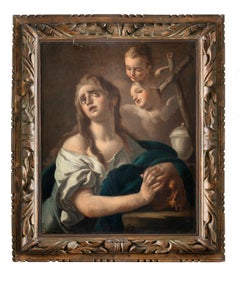
17th Century Oil Painting Portrait of Lady in Yellow Dress & Embroidered headdre
View Similar Items
Want more images or videos?
Request additional images or videos from the seller
1 of 8
17th Century Oil Painting Portrait of Lady in Yellow Dress & Embroidered headdrecirca 1650
circa 1650
About the Item
- Creation Year:circa 1650
- Dimensions:Height: 31 in (78.74 cm)Width: 26 in (66.04 cm)
- Medium:
- Movement & Style:
- Period:
- Condition:
- Gallery Location:London, GB
- Reference Number:1stDibs: LU67334200842
About the Seller
5.0
Vetted Seller
These experienced sellers undergo a comprehensive evaluation by our team of in-house experts.
Established in 1990
1stDibs seller since 2017
40 sales on 1stDibs
More From This SellerView All
- 18th C. Portrait of the 4th Earl of Sandwich a View of Constantinople BeyondLocated in London, GBJohn Montagu, 4th Earl of Sandwich (13 November 1718 – 30 April 1792) Attributed to George Knapton (1698-1778) Dressed in the Turkish manner, stand...Category
18th Century Old Masters Figurative Paintings
MaterialsOil
- 18th Century Oil Painting Portrait of Provost John Pitcairn of DundeeBy Sir Henry RaeburnLocated in London, GBThe pendant to the present portrait showing John Pitcairn's wife Jean, née Robertson, is in the Huntington Art Gallery, San Marino. Both works are datable to the 1790s. Pitcairn, who served as Provost of Dundee from 1782-84, a position his father-in-law also held from 1731-32, later sat to Raeburn for another portrait, dated to circa 1820, which is now in the Royal Scottish Academy, Edinburgh Sale of Christie's London: Wednesday, July 9, 2014 [Lot 00212] Old Master & British Paintings Day Sale Sold For 22,500 GBP Premium Provenance By descent from the sitter to his great-grandson, Ronald Andrew Pitcairn of Pitcullo; Christie's, London, 25 June 1904, lot 58 (200 gns. to Wallis). Alexander Reid, Glasgow. With Agnew's, London, where acquired by A.R. Wilson Wood, 7 April 1909; Christie's, London, 26 June 1914, lot 78 (850 gns. to Agnew). Anonymous sale; Christie's, London, 24 November 1972, lot 27 (320 gns.) Private collection, Dublin, Ireland Exhibition Edinburgh, Royal Scottish Academy, 1876, no. 256 Literature W. Armstrong, Sir Henry Raeburn, London, 1901, p. 110. J. Greig, Sir Henry Raeburn, R.A., His life and work with a catalogue of his pictures, London, 1911, p. 55. R. Asleson and S.M. Bennett, British Paintings at The Huntington, New Haven and London, 2001, p. 312, fig. 12 Sir Henry Raeburn FRSE RA RSA (4 March 1756 – 8 July 1823) was a Scottish portrait painter and Scotland's first significant portrait painter since the Union to remain based in Scotland. He served as Portrait Painter to King George IV in Scotland. Raeburn was born the son of a manufacturer in Stockbridge, on the Water of Leith: a former village now within the city of Edinburgh. He had an older brother, born in 1744, called William Raeburn. His ancestors were believed to have been soldiers, and may have taken the name "Raeburn" from a hill farm in Annandale, held by Sir Walter Scott's family. Orphaned, he was supported by William and placed in Heriot's Hospital, where he received an education. At the age of fifteen he was apprenticed to the goldsmith James Gilliland of Edinburgh, and various pieces of jewellery, mourning rings and the like, adorned with minute drawings on ivory by his hand, still exist. Soon he took to the production of carefully finished portrait miniatures; meeting with success and patronage, he extended his practice to oil painting, at which he was self-taught. Gilliland watched the progress of his pupil with interest, and introduced him to David Martin, who had been the favourite assistant of Allan Ramsay the Latter, and was now the leading portrait painter in Edinburgh. Raeburn was especially aided by the loan of portraits to copy. Soon he had gained sufficient skill to make him decide to devote himself exclusively to painting. George Chalmers (1776; Dunfermline Town Hall) is his earliest known portrait. In his early twenties, Raeburn was asked to paint the portrait of a young lady he had noticed when he was sketching from nature in the fields. Ann was the daughter of Peter Edgar of Bridgelands, and widow of Count James Leslie of Deanhaugh. Fascinated by the handsome and intellectual young artist, she became his wife within a month, bringing him an ample fortune. The acquisition of wealth did not affect his enthusiasm or his industry, but spurred him on to acquire a thorough knowledge of his craft. It was usual for artists to visit Italy, and Raeburn set off with his wife. In London he was kindly received by Sir Joshua Reynolds, the president of the Royal Academy, who advised him on what to study in Rome, especially recommending the works of Michelangelo, and gave Raeburn letters of introduction for Italy. In Rome he met his fellow Scot Gavin Hamilton, Pompeo Girolamo Batoni and Byers, an antique dealer whose advice proved particularly useful, especially the recommendation that "he should never copy an object from memory, but, from the principal figure to the minutest accessory, have it placed before him." After two years of study in Italy he returned to Edinburgh in 1787, and began a successful career as a portrait painter. In that year he executed a seated portrait of the second Lord President Dundas. Examples of his earlier portraiture include a bust of Mrs Johnstone of Baldovie and a three-quarter-length of Dr James Hutton...Category
18th Century Old Masters Figurative Paintings
MaterialsOil
- 17th Century Oil Painting Portrait of a Young English BoyBy Gerard SoestLocated in London, GBGerard SOEST (1600 - 1681) Portrait of a Young Boy oil on canvas 35.5 x 30.5 inches inc. frame Gerard Soest (circa 1600 – 11 February 1681), also known as Gerald Soest, was a portra...Category
17th Century Old Masters Portrait Paintings
MaterialsOil
- Stunning 17th Century Oil Painting - Study of a Head of a ManBy Anthony van DyckLocated in London, GBStudio of Sir Anthony Van Dyck (1599-1641, Flemish) Study of a Head of Man Circa 1627-32, Van Dyck’s second Antwerp period Oil on paper, laid down on canvas Dimensions 15 x 14 inches...Category
17th Century Old Masters Portrait Paintings
MaterialsOil
- Lady Dormore - A 16th Century Portrait of a key member of Shakespeare's EnglandLocated in London, GBLady Dormer, Mary Browne c. 1592 oil on panel 35 x 29 inches, unframed; 41 x 34.75 inches, inc. frame Inscribed 'Lady Dormore' Mary married Henry Wriothesley, 2nd Earl of Southampton who gave birth to Henry Wriothesley, 3rd Earl of Southampton - one of the great figures in Shakespears"s circle and founder of the Virginia company, developers of Virginia USA. Henry Wriothesley, born 6 October 1573 at Cowdray House, Sussex, was the only son of Henry Wriothesley, 2nd Earl of Southampton, by Mary Browne, the only daughter of Anthony Browne, 1st Viscount Montague, and his first wife, Jane Radcliffe.[5] He had two sisters, Jane, who died before 1573, and Mary (c. 1567 – 1607), who in June 1585 married Thomas Arundell, 1st Baron Arundell of Wardour.[6] After his father's death, Southampton's mother married firstly, on 2 May 1595, as his second wife, Sir Thomas Heneage (d. 17 October 1595), Vice-Chamberlain of the Household, and secondly, between 5 November 1598 and 31 January 1599, Sir William Hervey. She died in November 1607.[7] Early life When his father died on 4 October 1581 Southampton inherited the earldom and landed income valued at £1097 6s per annum. His wardship and marriage were sold by the Queen to her kinsman, Charles, Lord Howard of Effingham, for £1000. According to Akrigg, Howard then "entered into some further agreement, of which no documentation can now be found, which transferred to Lord Burghley personally the custody and marriage of the young Earl, but left Howard holding his lands", and late in 1581 or early in 1582 Southampton, then eight years of age, came to live at Cecil House in the Strand.[8] In October 1585, at age twelve, Southampton entered St John's College, Cambridge,[9] graduating M.A. on 6 June 1589.[10] His name was entered at the Gray's Inn legal society before he left the university, and he was admitted on 29 February 1588.[11] On Southampton's 16th birthday, 6 October 1589, Lord Burghley noted Southampton's age in his diary, and by 1590 Burghley was negotiating with Southampton's grandfather, Anthony Browne, 1st Viscount Montague, and Southampton's mother, Mary, for a marriage between Southampton and Lord Burghley's eldest granddaughter, Elizabeth Vere, daughter of Burghley's daughter, Anne Cecil, and Edward de Vere...Category
16th Century Old Masters Figurative Paintings
MaterialsOil
- Double Portrait Oil Painting Brothers George, 2nd Duke Buckingham & Lord FrancisBy (After) Anthony Van DyckLocated in London, GBAftrer Anthony VAN DYCK - maybe Studio (1599, Antwerp – 1641, London) Flemish Double Portrait of George Villiers, 2nd Duke of Buckingham (1628-1687) & Lord Francis Villiers (1629-1648) Oil on Canvas 170 x 147 cm Anthony Van Dyck (1599-1641) No painter has done more to define an era than Anthony van Dyck. He spent only seven and a half years of his short life (1599- 1641) in England. He grew up in Antwerp, where his precocious talent was recognised by Peter Paul Rubens, the greatest painter of his age. He worked in Rubens’s studio and imitated his style as a religious artist, painting biblical scenes redolent of the lush piety of the counter-reformation. But soon he was on the move. In 1620, he visited London for a few months, long enough to paint a history picture, The Continence of Scipio, for the royal favourite, George Villiers, Marquess of Buckingham, and a portrait of his other English patron, the great art collector, Thomas Howard, 2nd Earl of Arundel. After a stint in Italy, making imposing portraits of the wealthy aristocracy and sketching and copying works by Titian, he returned to the Spanish Netherlands in 1627, becoming court artist to Archduchess Isabella before departing for The Hague in 1631 to paint the Dutch ruler Frederick Henry, Prince of Orange. Charles I’s invitation in 1632 led Van Dyck back to London where he was knighted, paid an annual salary of £200 and installed in a house in Blackfriars with a special jetty at which the royal barge might tie up when the King was visiting his studio. By this time Van Dyck was recognised as the leading court painter in Europe, with Velazquez at the court of Philip IV of Spain his only rival. He also excelled as a superbly observant painter of children and dogs. Van Dyck’s notoriety in depicting children led to the introduction of groups of children without their parents as a new genre into English painting (amongst other new genres). For the next 300 years, Van Dyck was the major influence on English portraiture. Nearly all the great 18th Century portraitists, from Pompeo Batoni and Allan Ramsay to Thomas Gainsborough and Joshua Reynolds, copied Van Dyck’s costumes, poses and compositions. George Duke of Buckingham & his brother Francis Villiers Painted in 1635, this double portrait was originally commissioned by Charles I, who raised the two brothers after their father, George Villiers, was assassinated in 1628. Together with their sister, Lady Mary Villiers, they enjoyed the King’s favour absolutely. Francis whose absolute ‘inimitable handsomeness’ was noted by Marvell (who was killed in a skirmish near Kingston upon Thames). The young duke who commanded a regiment of horse at the Battle of Worcester, remained closely associated with Charles II, held a number of high offices after the Restoration and was one of the most cynical and brilliant members of the King’s entourage, immortalised as ‘Zimri’ in Dryden’s Absalom and Achitopbel. As a young man he had sold his father’s great collection of pictures in the Spanish Netherlands, many of them to the Archduke Leopold Willhelm. Painted for Charles I and placed near the portrait of their sister in the Gallery at St James’ Palace. The handling of both costumes is very rich, and the heads are very carefully and sensitively worked. That of the younger boy in particular is more solidly built up than the lower part of the figure. A preparatory drawing for the younger boy is in the British Museum. There are copies at, e.g., Highclere Castle...Category
17th Century Old Masters Portrait Paintings
MaterialsOil
You May Also Like
- Portrait of a Lady, After Sir Peter Lely (1610-1680) Oil PaintingBy After Sir Peter LelyLocated in Uppingham, GBOil Painting After Sir Peter Lely (1610-1680) Portrait of a Lady Housed in a Lely gold Leaf Frame. Peter Lely: In 1647 he became a member of the Pain...Category
17th Century Old Masters Portrait Paintings
MaterialsOil
- Portrait of Jean-Baptiste Greuze, painted on linen by his daughter Anna GreuzeLocated in PARIS, FRThis replica of the last self-portrait of Jean-Baptiste Greuze painted in 1804, executed by his daughter Anna at her father's side and recently rediscovered, provides us with a poignant image of the great artist, represented with panache despite the disillusions of life. 1. Jean-Baptiste Greuze Jean-Baptiste Greuze was the sixth child of a roofer from Tournus and retained a certain rusticity in his behaviour from his provincial childhood, beyond his taste for describing picturesque scenes of the countryside. He initially started training with a little-known painter from Lyon, Charles Grandon, before his genius was recognised in Paris where he became a full-time student of the Académie (of Painting) in 1755. He exhibited his work for the first time at the Salon during the summer of 1755, before leaving on a trip to Italy in the company of Louis Gougenot, abbot of Chezal-Benoît. Upon his return to Paris, Greuze became a prolific painter, participating widely in the Salons held between 1759 and 1765, to which he sent no less than 63 paintings: numerous genre scenes (The Marriage Contract, The Beloved Mother), but also portraits of his family circle, of courtiers and art lovers, or of his colleagues. The Academy closed the doors of the Salons to him in 1767 for not having produced his reception piece within six months of his reception, as was the tradition. He worked actively on this painting (Emperor Severus rebukes Caracalla, his son, for trying to assassinate him ) until the summer of 1769, tackling historical and mythological subjects for the first time. Once this was completed, he was then fully admitted to the Academy, but as a genre painter, and not as an historical painter, which had been one of the greatest humiliations of his life. Greuze then refused any participation in events organised by the Academy or its successor, the Academy of Fine Arts until 1800. Abandoning history painting, he gave a new twist to genre scenes, bringing them closer to history painting, as in this pair of canvases which constitutes some of his masterpieces: The Paternal Curse: The Ungrateful Son and The Paternal Curse: The Punished Son . Married in 1759 to Anne-Gabrielle Babuti, the daughter of a Parisian bookseller, his marriage was unhappy and his wife probably frequently unfaithful. The institution of divorce enabled him to record their separation in 1793, keeping his two daughters Anna-Geneviève, born in April 1762, and Louise-Gabrielle, born in May 1764, with him. Little is known about his daughter Anna except that she was herself a painter and lived with her father until his death. It is likely that most of the paintings she produced up to that date were attributed to her father, whose technique she shared to a great extent, making it extremely difficult to establish an autonomous corpus of her paintings. Greuze died in his studio at the Louvre on March 21st 1805. The attention paid to the expressivity of his characters and the emotional charge they convey enabled Jean-Baptiste Greuze to enjoy immense popularity with the eighteenth-century public, and they still constitute Greuze's true modernity. As the artist said, "I dipped my brush in my heart". Greuze was also an exceptional draughtsman and a portraitist of immense talent and exceptional longevity who painted both the Dauphin (the son of Louis XV and father to Louis XVI) and the young Napoleon Bonaparte. 2. Greuze's self-portraits Greuze was very much influenced by Dutch paintings during all his life. While the source of his inspiration for genre scenes can be found in Gerard Dou...Category
Early 1800s Old Masters Portrait Paintings
MaterialsLinen, Oil
- 18th Century by Pietro Bardellino Mary Magdalene Painting Oil on CanvasBy Pietro BardellinoLocated in Milano, LombardiaPietro Bardellino (Naples, 1731 – Naples, 1806) Mary Magdalene Oil on canvas, cm. 75 x 60 – with frame cm. 97 x 82 Antique shaped and carved wooden frame Publications: unpublished T...Category
Mid-18th Century Old Masters Portrait Paintings
MaterialsCanvas, Oil
- 18th Century by Antonio Mercurio Amorosi Portrait Little Girl with CatBy Antonio Mercurio AmorosiLocated in Milano, LombardiaAntonio Mercurio Amorosi (Comunanza 1660 - 1738) Portrait of a little girl with cat Oil on canvas, cm. 42 x 31.5 – with frame cm. 56 x 44 Shaped, carved and gilded wooden cassetta fr...Category
Early 18th Century Old Masters Portrait Paintings
MaterialsOil, Canvas
- 17th Century by Giuseppe Assereto Portrait of an Elderly Woman Oil on CanvasBy Giuseppe AsseretoLocated in Milano, LombardiaGiuseppe Assereto (Genova - 1626 ca – Genova 1656/57) Portrait of an elderly woman, possible portrait of Maddalena Massone, wife of Gioacchino Assereto Oil on canvas, cm. 65,5 x 51,5...Category
Early 17th Century Old Masters Portrait Paintings
MaterialsCanvas, Oil
- 17th Century by Juan Alfonso Abril Head of St Paul Painting Oil on CanvasLocated in Milano, LombardiaJuan Alfonso Abril (active in the 17th century in Valladolid) Head of Saint Paul Oil on canvas, cm. 48,5 x 62 - with frame cm. 63 x 76,5 Shaped wooden f...Category
Early 17th Century Old Masters Figurative Paintings
MaterialsCanvas, Oil
Recently Viewed
View AllMore Ways To Browse
Young Noble
New 18th C Painting
Lace Dress Painting
Old Master Portrait Lady
Antique 19th Century English Portrait Painting
Antique Pictures Of Children
Antique Portrait Of A Lady
Painting Oriental Portrait
Large Antique French Portrait
Lady Dior New
English Gentleman Portrait
Antique Catholic Art
Christ Portrait Paintings
St Augustine
Italian Oil Portrait 18th Century
Aristocratic Portrait Paintings
English Portrait Of Gentleman
Lady In Green Painting
